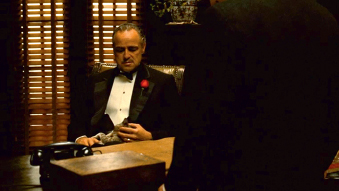Chapter 9: Introduction
Telling the Story through Lighting
9
CHAPTER
“I always feel if I can nail the black tones, the rest of the film is going to fall into place.”
– Bradford Young, cinematographer for Ain’t Them Bodies Saints (2013) and A Most Violent Year (2014)

The Godfather (1972)
KEY CONCEPTS
 Once you determine the film’s visual style, you will need comprehensive planning and preparation to execute it well.
Once you determine the film’s visual style, you will need comprehensive planning and preparation to execute it well. Outdoor scenes use natural light, though not exclusively, and you will need to control constant variations in sunlight and weather.
Outdoor scenes use natural light, though not exclusively, and you will need to control constant variations in sunlight and weather. Indoor scenes have their own unique requirements, and you will have near-total control of the lighting.
Indoor scenes have their own unique requirements, and you will have near-total control of the lighting. You must be prepared for the special lighting situations you will encounter, including low light and lighting for people with different skin tones, among others.
You must be prepared for the special lighting situations you will encounter, including low light and lighting for people with different skin tones, among others.
There had never been a studio movie as dark as The Godfather (1972). Not dark as in grim and violent, although it was that, at times—dark, as in very little light. It was a visual style choice that originally became necessary to obscure the use of prosthetic makeup, and then shaped the entire storytelling approach for the now-classic film.
One of the problems with prosthetic makeup is that it shines, which makes it look fake and unlike real skin. One solution: light from the top instead of from the sides, so there’s no shiny reflection. “A lot of what I did with overhead lighting came out of necessity of dealing with Marlon Brando in a given kind of makeup,” the late cinematographer Gordon Willis recalled.1 Actor Marlon Brando, who won the Academy Award for his portrayal of aging Mafia patriarch Don Corleone, was only 47 years old when he made the film. He wore heavy prosthetics, designed by the legendary, late makeup artist, Dick Smith, to create a jutting jaw, weighty jowls, and a thinning hairline.
“It was an example of designing something to make one person work, and it was extended throughout the rest of the movie.” Willis noted. “I got a lot of criticism because they said, ‘Well, we can’t see Brando’s eyes.’ There were times in some of his scenes where I deliberately did not want to see his eyes, so that you saw this mysterious human being thinking about something, or about to do something, but you didn’t really know what the hell was going on.”
Willis’s creative choice fused perfectly with director Francis Ford Coppola’s vision, and the resulting film, full of deep blacks and rich earth tones, became an instant masterpiece and won the Academy Award for Best Picture.
In Chapter 8, you learned the basic tools you need to craft lighting. In this chapter, you will discover how to fuse art with that craft—how to employ the qualities of light to convey story, character, and emotion. In the final analysis, a movie can survive poor lighting and photography if the characters and story are excellent, but excellent visuals won’t make a bad story work. The best movies, however, like The Godfather, combine both: visual artistry and storytelling magic.
Your job as cinematographer will be to understand lighting principles and rules fully, and then feel comfortable breaking the rules when the movie you’re working on demands it. The first question you’ll confront, and discuss with your director, will be a matter of style.